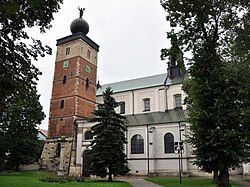Miechów
| Miechów | ||
|---|---|---|

|
||
|
||
| Coordinates: 50°21′28″N 20°1′57″E / 50.35778°N 20.03250°E | ||
| Country |
|
|
| Voivodeship | Lesser Poland | |
| County | Miechów County | |
| Gmina | Gmina Miechów | |
| Government | ||
| • Mayor | Dariusz Marczewski | |
| Area | ||
| • Total | 15.49 km2 (5.98 sq mi) | |
| Population (2010) | ||
| • Total | 11,497 | |
| • Density | 740/km2 (1,900/sq mi) | |
| Time zone | CET (UTC+1) | |
| • Summer (DST) | CEST (UTC+2) | |
| Postal code | 32-200 | |
| Car plates | KMI | |
| Website | http://www.miechow.eu/ | |
Miechów [ˈmʲɛxuf] is a town in Poland, in Lesser Poland Voivodeship, about 40 kilometres (25 miles) north of Kraków. It is the capital of Miechów County. Population is 11,852 (2004). Miechów lies on the Miechówka river, along European route E77. The area of the town is 15 square kilometres (6 sq mi), and it has a rail station, located on the main railroad which connects Kraków with Warsaw.
In the early years of the Polish state, the area of Miechów belonged to the medieval tribe of the Vistulans. In the late 10th century, the region was taken over by the Polans. The beginning of Miechów dates back to the year 1163, when a Polish Duke of Pomerania Jaksa of the House of Griffins, who owned the village, invited monks of the Order of the Holy Sepulchre. Apart from Miechów, prince Jaksa handed two other villages to the order.
The new church with a monastery was blessed by the Bishop of Kraków Gędka in 1170. Miechów took advantage of the presence of the order. The settlement expanded together with the abbey, and in 1290 prince Przemysł II granted it the town charter based on Magdeburg rights. Despite convenient location along merchant routes, Miechów grew very slowly, due to numerous wars and conflicts. In the early 14th century, the town was burned down by Prince of Masovia Bolesław, who supported Władysław Łokietek. This incident took place during the Rebellion of wójt Albert, in which the town and the abbey supported the rebels. As a result, the monks were forced to leave Poland for a few years. After their return, King Łokietek banned Germans from the post of the abbot of the monastery. In the second half of the 15th century Miechów burned several times, and in the early 16th century, it had 70 houses. In 1525 the abbey was expanded, when Chapel of Tomb of Christ was built. Pilgrims from all over Poland began to come here. Miechów had a wooden town hall in the market square.
...
Wikipedia


